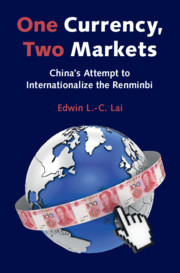Book contents
- One Currency, Two Markets
- One Currency, Two Markets
- Copyright page
- Dedication
- Contents
- Figures
- Tables
- Boxes
- Preface
- Acknowledgments
- A Short Summary of This Book
- Abbreviations
- 1 Introduction
- 2 China’s Aversion to a Floating Exchange Rate
- 3 Why Does China Want to Internationalize the RMB?
- 4 China’s Strategy of Internationalizing the RMB
- 5 The Importance of Capital Account Liberalization
- 6 The Importance of Financial Sector Reform
- 7 The Importance of the Offshore RMB Market
- 8 The Potential of the RMB as a Payment Currency
- 9 The Prospects of RMB Internationalization
- References
- Further Reading
- Index
1 - Introduction
Published online by Cambridge University Press: 17 June 2021
- One Currency, Two Markets
- One Currency, Two Markets
- Copyright page
- Dedication
- Contents
- Figures
- Tables
- Boxes
- Preface
- Acknowledgments
- A Short Summary of This Book
- Abbreviations
- 1 Introduction
- 2 China’s Aversion to a Floating Exchange Rate
- 3 Why Does China Want to Internationalize the RMB?
- 4 China’s Strategy of Internationalizing the RMB
- 5 The Importance of Capital Account Liberalization
- 6 The Importance of Financial Sector Reform
- 7 The Importance of the Offshore RMB Market
- 8 The Potential of the RMB as a Payment Currency
- 9 The Prospects of RMB Internationalization
- References
- Further Reading
- Index
Summary
Chapter 1 is the introduction. I discuss the current state of the international monetary system (IMS), the “exorbitant privilege” of the United States and the history of the IMS. I explain how the United States seized the opportunity in the Bretton Woods conference to establish the USD as the reserve currency, and how the Bretton Woods system collapsed in 1972. Today, under the post-Bretton Woods system, developing countries like China adopt the “dollar standard” and peg their currencies to the USD. In doing so, China accumulates huge amounts of USD foreign reserves. It falls into the “dollar trap”. However, the global financial crisis sounded an alarm for China that the dollar-based IMS could be quite unreliable, e.g., there might be a shortage of the USD for trade finance. Thus, China began to accelerate the pace of RMB internationalization, aiming to make the RMB an international unit of account, medium of exchange, and store of value. However, this implies that its capital account has to be open, the financial market must be liberalized, and its exchange rate has to be more volatile. Is China ready to meet this challenge? This book investigates the necessary conditions for RMB internationalization to succeed and its prospects.
- Type
- Chapter
- Information
- One Currency, Two MarketsChina's Attempt to Internationalize the Renminbi, pp. 1 - 21Publisher: Cambridge University PressPrint publication year: 2021



